Insights into Molecular Mechanism of Secondary Xylem Rapid Growth in Salix psammophila
Abstract
1. Introduction
2. Results
2.1. Development Characteristics of Secondary Xylem and Phloem in Stem of S. psammophila
2.2. RNA-seq Sequencing and Alignment to Reference Genome
2.3. Analysis of DEGs in Secondary Xylem and Phloem
2.4. GO Annotation of DEGs During Stem Xylem and Phloem Development
2.5. Analysis of Genes Related to Lignin Synthesis Pathways in Secondary Xylem and Secondary Phloem of Stems
2.6. Weighted Gene Co-Expression Network Analysis (WGCNA) Identified TFs Involved in Different Developmental Stages During Secondary Growth Stems
3. Discussion
4. Materials and Methods
4.1. Plant Material, RNA Extraction, and Sequencing
4.2. RNA-seq Data Analysis
5. Conclusions
Supplementary Materials
Author Contributions
Funding
Data Availability Statement
Conflicts of Interest
Abbreviations
| CSE | caffeoyl shikimate esterase |
| DEG | differentially expressed gene |
| SCW | secondary cell wall |
| TF | transcription factor |
| WGCNA | weighted gene co-expression network analysis |
References
- Jia, H.; Zhang, J.; Li, J.; Sun, P.; Zhang, Y.; Xin, X.; Lu, M.; Hu, J. Genome-Wide Transcriptomic Analysis of a Desert Willow, Salix psammophila, Reveals the Function of Hub Genes SpMDP1 and SpWRKY33 in Drought Tolerance. BMC Plant Biol. 2019, 19, 356. [Google Scholar] [CrossRef] [PubMed]
- Jia, H.; Li, J.; Zhang, J.; Sun, P.; Lu, M.; Hu, J. The Salix psammophila SpRLCK1 Involved in Drought and Salt Tolerance. Plant Physiol. Biochem. 2019, 144, 222–233. [Google Scholar] [CrossRef] [PubMed]
- Yang, H.; Fan, L.; Yu, X.; Zhang, X.; Hao, P.; Wei, D.; Zhang, G. Analysis of the NAC Gene Family in Salix and the Identification of SpsNAC005 Gene Contributing to Salt and Drought Tolerance. Forests 2022, 13, 971. [Google Scholar] [CrossRef]
- Bao, Y.; Zhang, G. Study of Adsorption Characteristics of Methylene Blue onto Activated Carbon Made by Salix psammophila. Energy Procedia 2012, 16, 1141–1146. [Google Scholar] [CrossRef]
- Qu, L.; Chen, J.C.; Yang, G.H.; Xue, Y. Effect of Different Process on the Pulping Properties of Salix psammophila P-RC APMP. AMR 2012, 610-613, 581–585. [Google Scholar] [CrossRef]
- Kim, M.-H.; Bae, E.-K.; Lee, H.; Ko, J.-H. Current Understanding of the Genetics and Molecular Mechanisms Regulating Wood Formation in Plants. Genes 2022, 13, 1181. [Google Scholar] [CrossRef] [PubMed]
- Hao, L.; Zhang, G.; Lu, D.; Hu, J.; Jia, H. Analysis of the Genetic Diversity and Population Structure of Salix psammophila Based on Phenotypic Traits and Simple Sequence Repeat Markers. PeerJ 2019, 7, e6419. [Google Scholar] [CrossRef]
- Hao, L.; Zhai, Y.; Zhang, G.; Lu, D.; Huang, H. Efficient Fingerprinting of the Tetraploid Salix psammophila Using SSR Markers. Forests 2020, 11, 176. [Google Scholar] [CrossRef]
- Shi, Q.; Yang, X.; Zhao, B.; Liu, Z.; Liu, Y.; Liu, X.; Wang, L. Enhanced Absorption of Hg2+ by a Recyclable Thiol-Functionalized Salix psammophila. Water Air Soil Pollut. 2022, 233, 13. [Google Scholar] [CrossRef]
- Wang, R.; Gao, Y.; Dang, X.; Yang, X.; Liang, Y.; Zhao, C. Microstructure and Biodegradation of Long-Established Salix psammophila Sand Barriers on Sand Dunes. Environ. Technol. Innov. 2021, 21, 101366. [Google Scholar] [CrossRef]
- Ji, Y.; Lin, Q.; Huang, Y.; Rao, F.; Yu, W. High-Performance Wood Composites from Desert Shrub Salix psammophila. Green Mater. 2019, 7, 177–184. [Google Scholar] [CrossRef]
- Liu, L.; Filkov, V.; Groover, A. Modeling Transcriptional Networks Regulating Secondary Growth and Wood Formation in Forest Trees. Physiol. Plant. 2014, 151, 156–163. [Google Scholar] [CrossRef] [PubMed]
- Li, R.; Wang, Z.; Wang, J.-W.; Li, L. Combining Single-Cell RNA Sequencing with Spatial Transcriptome Analysis Reveals Dynamic Molecular Maps of Cambium Differentiation in the Primary and Secondary Growth of Trees. Plant Commun. 2023, 4, 100665. [Google Scholar] [CrossRef] [PubMed]
- Zhou, F.; Zhang, H.; Chen, S.; Fan, C. Transcriptome Analysis of the Transition from Primary to Secondary Growth of Vertical Stem in Eucalyptus grandis. BMC Plant Biol. 2024, 24, 96. [Google Scholar] [CrossRef]
- Luo, L.; Li, L. Molecular Understanding of Wood Formation in Trees. For. Res. 2022, 2, 5. [Google Scholar] [CrossRef] [PubMed]
- Moreau, C.; Aksenov, N.; Lorenzo, M.G.; Segerman, B.; Funk, C.; Nilsson, P.; Jansson, S.; Tuominen, H. A Genomic Approach to Investigate Developmental Cell Death in Woody Tissues of Populus trees. Genome Biol. 2005, 6, R34. [Google Scholar] [CrossRef]
- Nguyen, V.P.; Cho, J.-S.; Choi, Y.-I.; Lee, S.-W.; Han, K.-H.; Ko, J.-H. Evaluation of a Novel Promoter from Populus trichocarpa for Mature Xylem Tissue Specific Gene Delivery. Plant Physiol. Biochem. 2016, 104, 226–233. [Google Scholar] [CrossRef] [PubMed]
- Meents, M.J.; Watanabe, Y.; Samuels, A.L. The Cell Biology of Secondary Cell Wall Biosynthesis. Ann. Bot. 2018, 121, 1107–1125. [Google Scholar] [CrossRef] [PubMed]
- Tang, Y.; Lu, L.; Sheng, Z.; Zhao, D.; Tao, J. An R2R3-MYB Network Modulates Stem Strength by Regulating Lignin Biosynthesis and Secondary Cell Wall Thickening in Herbaceous Peony. Plant J. 2023, 113, 1237–1258. [Google Scholar] [CrossRef] [PubMed]
- Polko, J.K.; Kieber, J.J. The Regulation of Cellulose Biosynthesis in Plants. Plant Cell 2019, 31, 282–296. [Google Scholar] [CrossRef]
- Zhang, W.; Qin, W.; Li, H.; Wu, A. Biosynthesis and Transport of Nucleotide Sugars for Plant Hemicellulose. Front. Plant Sci. 2021, 12, 723128. [Google Scholar] [CrossRef] [PubMed]
- Lu, Q.; Shao, F.; Macmillan, C.; Wilson, I.W.; Van Der Merwe, K.; Hussey, S.G.; Myburg, A.A.; Dong, X.; Qiu, D. Genomewide Analysis of the Lateral Organ Boundaries Domain Gene Family in Eucalyptus grandis Reveals Members That Differentially Impact Secondary Growth. Plant Biotechnol. J. 2018, 16, 124–136. [Google Scholar] [CrossRef]
- Chen, H.; Wang, J.P.; Liu, H.; Li, H.; Lin, Y.-C.J.; Shi, R.; Yang, C.; Gao, J.; Zhou, C.; Li, Q.; et al. Hierarchical Transcription Factor and Chromatin Binding Network for Wood Formation in Populus trichocarpa. Plant Cell 2019, 31, 602–626. [Google Scholar] [CrossRef]
- Xiao, R.; Zhang, C.; Guo, X.; Li, H.; Lu, H. MYB Transcription Factors and Its Regulation in Secondary Cell Wall Formation and Lignin Biosynthesis during Xylem Development. Int. J. Mol. Sci. 2021, 22, 3560. [Google Scholar] [CrossRef] [PubMed]
- Yi, N.; Yang, H.; Zhang, X.; Pian, R.; Li, H.; Zeng, W.; Wu, A.-M. The Physiological and Transcriptomic Study of Secondary Growth in Neolamarckia Cadamba Stimulated by the Ethylene Precursor ACC. Plant Physiol. Biochem. 2022, 190, 35–46. [Google Scholar] [CrossRef]
- Roy, S. Function of MYB Domain Transcription Factors in Abiotic Stress and Epigenetic Control of Stress Response in Plant Genome. Plant Signal. Behav. 2016, 11, e1117723. [Google Scholar] [CrossRef]
- Guo, H.; Wang, Y.; Wang, L.; Hu, P.; Wang, Y.; Jia, Y.; Zhang, C.; Zhang, Y.; Zhang, Y.; Wang, C.; et al. Expression of the MYB Transcription Factor Gene BplMYB46 Affects Abiotic Stress Tolerance and Secondary Cell Wall Deposition in Betula platyphylla. Plant Biotechnol. J. 2017, 15, 107–121. [Google Scholar] [CrossRef]
- Legay, S.; Lacombe, E.; Goicoechea, M.; Brière, C.; Séguin, A.; Mackay, J.; Grima-Pettenati, J. Molecular Characterization of EgMYB1, a Putative Transcriptional Repressor of the Lignin Biosynthetic Pathway. Plant Sci. 2007, 173, 542–549. [Google Scholar] [CrossRef]
- Legay, S.; Sivadon, P.; Blervacq, A.; Pavy, N.; Baghdady, A.; Tremblay, L.; Levasseur, C.; Ladouce, N.; Lapierre, C.; Séguin, A.; et al. EgMYB1, an R2R3 MYB Transcription Factor from Eucalyptus Negatively Regulates Secondary Cell Wall Formation in Arabidopsis and Poplar. New Phytol. 2010, 188, 774–786. [Google Scholar] [CrossRef] [PubMed]
- Jiao, B.; Zhao, X.; Lu, W.; Guo, L.; Luo, K. The R2R3 MYB Transcription Factor MYB189 Negatively Regulates Secondary Cell Wall Biosynthesis in Populus. Tree Physiol. 2019, 39, 1187–1200. [Google Scholar] [CrossRef]
- Zhong, R.; Lee, C.; Ye, Z.-H. Evolutionary Conservation of the Transcriptional Network Regulating Secondary Cell Wall Biosynthesis. Trends Plant Sci. 2010, 15, 625–632. [Google Scholar] [CrossRef]
- Sun, P.; Wang, H.; Zhao, P.; Yu, Q.; He, Y.; Deng, W.; Guo, H. The Regulation of Xylem Development by Transcription Factors and Their Upstream MicroRNAs. Int. J. Mol. Sci. 2022, 23, 10134. [Google Scholar] [CrossRef] [PubMed]
- Zhong, R.; Kandasamy, M.K.; Ye, Z.-H. XND1 Regulates Secondary Wall Deposition in Xylem Vessels through the Inhibition of VND Functions. Plant Cell Physiol. 2021, 62, 53–65. [Google Scholar] [CrossRef]
- Johnsson, C.; Jin, X.; Xue, W.; Dubreuil, C.; Lezhneva, L.; Fischer, U. The Plant Hormone Auxin Directs Timing of Xylem Development by Inhibition of Secondary Cell Wall Deposition through Repression of Secondary Wall NAC-domain Transcription Factors. Physiol. Plant 2019, 165, 673–689. [Google Scholar] [CrossRef] [PubMed]
- Schuster, S.C. Next-Generation Sequencing Transforms Today’s Biology. Nat. Methods 2008, 5, 16–18. [Google Scholar] [CrossRef] [PubMed]
- Chen, J.; Liu, F.; Tang, Y.; Yuan, Y.; Guo, Q. Transcriptome Sequencing and Profiling of Expressed Genes in Phloem and Xylem of Ramie (Boehmeria nivea L. Gaud). PLoS ONE 2014, 9, e110623. [Google Scholar] [CrossRef] [PubMed]
- Wang, H.-Z.; Dixon, R.A. On-Off Switches for Secondary Cell Wall Biosynthesis. Mol. Plant 2012, 5, 297–303. [Google Scholar] [CrossRef]
- Fischer, U.; Kucukoglu, M.; Helariutta, Y.; Bhalerao, R.P. The Dynamics of Cambial Stem Cell Activity. Annu. Rev. Plant Biol. 2019, 70, 293–319. [Google Scholar] [CrossRef]
- Wang, D.; Chen, Y.; Li, W.; Li, Q.; Lu, M.; Zhou, G.; Chai, G. Vascular Cambium: The Source of Wood Formation. Front. Plant Sci. 2021, 12, 700928. [Google Scholar] [CrossRef]
- Wang, Q.; Wang, Y.; Lu, X.; Chen, Y.; Chen, Y.; Wu, X.; Zhou, G.; Chai, G. Wood Forming Tissue-Specific Expression of PaTyDC4 Promotes Xylem Differentiation and Lignin Deposition during Secondary Growth and Confers Drought Tolerance in Populus. Hortic. Plant J. 2024, in press. [Google Scholar] [CrossRef]
- Hao, Y.; Lu, F.; Pyo, S.-W.; Kim, M.-H.; Ko, J.-H.; Yan, X.; Ralph, J.; Li, Q. PagMYB128 Regulates Secondary Cell Wall Formation by Direct Activation of Cell Wall Biosynthetic Genes during Wood Formation in Poplar. J. Integr. Plant Biol. 2024, 66, 1658–1674. [Google Scholar] [CrossRef]
- Lu, J.; Shi, Y.; Li, W.; Chen, S.; Wang, Y.; He, X.; Yin, X. RcPAL, a Key Gene in Lignin Biosynthesis in Ricinus communis L. BMC Plant Biol. 2019, 19, 181. [Google Scholar] [CrossRef] [PubMed]
- Goicoechea, M.; Lacombe, E.; Legay, S.; Mihaljevic, S.; Rech, P.; Jauneau, A.; Lapierre, C.; Pollet, B.; Verhaegen, D.; Chaubet-Gigot, N.; et al. EgMYB2, a New Transcriptional Activator from Eucalyptus Xylem, Regulates Secondary Cell Wall Formation and Lignin Biosynthesis. Plant J. 2005, 43, 553–567. [Google Scholar] [CrossRef]
- Ha, C.M.; Escamilla-Trevino, L.; Yarce, J.C.S.; Kim, H.; Ralph, J.; Chen, F.; Dixon, R.A. An Essential Role of Caffeoyl Shikimate Esterase in Monolignol Biosynthesis in Medicago truncatula. Plant J. 2016, 86, 363–375. [Google Scholar] [CrossRef] [PubMed]
- Zhao, Q. Lignification: Flexibility, Biosynthesis and Regulation. Trends Plant Sci. 2016, 21, 713–721. [Google Scholar] [CrossRef]
- Barros, J.; Escamilla-Trevino, L.; Song, L.; Rao, X.; Serrani-Yarce, J.C.; Palacios, M.D.; Engle, N.; Choudhury, F.K.; Tschaplinski, T.J.; Venables, B.J.; et al. 4-Coumarate 3-Hydroxylase in the Lignin Biosynthesis Pathway Is a Cytosolic Ascorbate Peroxidase. Nat. Commun. 2019, 10, 1994. [Google Scholar] [CrossRef]
- Quan, M.; Du, Q.; Xiao, L.; Lu, W.; Wang, L.; Xie, J.; Song, Y.; Xu, B.; Zhang, D. Genetic Architecture Underlying the Lignin Biosynthesis Pathway Involves Noncoding RNAs and Transcription Factors for Growth and Wood Properties in Populus. Plant Biotechnol. J. 2019, 17, 302–315. [Google Scholar] [CrossRef] [PubMed]
- Vanholme, R.; Cesarino, I.; Rataj, K.; Xiao, Y.; Sundin, L.; Goeminne, G.; Kim, H.; Cross, J.; Morreel, K.; Araujo, P.; et al. Caffeoyl Shikimate Esterase (CSE) Is an Enzyme in the Lignin Biosynthetic Pathway in Arabidopsis. Science 2013, 341, 1103–1106. [Google Scholar] [CrossRef]
- Wang, X.; Chao, N.; Zhang, A.; Kang, J.; Jiang, X.; Gai, Y. Systematic Analysis and Biochemical Characterization of the Caffeoyl Shikimate Esterase Gene Family in Poplar. Int. J. Mol. Sci. 2021, 22, 13366. [Google Scholar] [CrossRef] [PubMed]
- Sette Jr, C.R.; da Cunha, T.Q.G.; Coneglian, A.; Hansted, A.L.S.; da Silva, D.A.; Lima, P.A.F.; da Silva, M.F.; Yamaji, F.M. Does the Presence of Bark in the Wood of Fast-Growing Forest Species Significantly Change the Energy Potential? Bioenerg. Res. 2020, 13, 222–228. [Google Scholar] [CrossRef]
- Langfelder, P.; Horvath, S. WGCNA: An R Package for Weighted Correlation Network Analysis. BMC Bioinform. 2008, 9, 559. [Google Scholar] [CrossRef] [PubMed]
- Toubiana, D.; Puzis, R.; Sadka, A.; Blumwald, E. A Genetic Algorithm to Optimize Weighted Gene Co-Expression Network Analysis. J. Comput. Biol. 2019, 26, 1349–1366. [Google Scholar] [CrossRef] [PubMed]
- Ye, Z.-H.; Zhong, R. Molecular Control of Wood Formation in Trees. J. Exp. Bot. 2015, 66, 4119–4131. [Google Scholar] [CrossRef]
- Soler, M.; Plasencia, A.; Larbat, R.; Pouzet, C.; Jauneau, A.; Rivas, S.; Pesquet, E.; Lapierre, C.; Truchet, I.; Grima-Pettenati, J. The Eucalyptus Linker Histone Variant EgH1.3 Cooperates with the Transcription Factor EgMYB1 to Control Lignin Biosynthesis during Wood Formation. New Phytol. 2017, 213, 287–299. [Google Scholar] [CrossRef]
- Zhong, R.; Demura, T.; Ye, Z.-H. SND1, a NAC Domain Transcription Factor, Is a Key Regulator of Secondary Wall Synthesis in Fibers of Arabidopsis. Plant Cell 2006, 18, 3158–3170. [Google Scholar] [CrossRef]
- Chao, Q.; Gao, Z.-F.; Zhang, D.; Zhao, B.-G.; Dong, F.-Q.; Fu, C.-X.; Liu, L.-J.; Wang, B.-C. The Developmental Dynamics of the Populus Stem Transcriptome. Plant Biotechnol. J. 2019, 17, 206–219. [Google Scholar] [CrossRef]
- Zhang, L.; Yang, T.; Wang, Z.; Zhang, F.; Li, N.; Jiang, W. Genome-Wide Identification and Expression Analysis of the PLATZ Transcription Factor in Tomato. Plants 2023, 12, 2632. [Google Scholar] [CrossRef]
- Saleme, M.d.L.S.; Cesarino, I.; Vargas, L.; Kim, H.; Vanholme, R.; Goeminne, G.; Van Acker, R.; Fonseca, F.C.d.A.; Pallidis, A.; Voorend, W.; et al. Silencing CAFFEOYL SHIKIMATE ESTERASE Affects Lignification and Improves Saccharification in Poplar. Plant Physiol. 2017, 175, 1040–1057. [Google Scholar] [CrossRef] [PubMed]
- Vanholme, R.; Morreel, K.; Darrah, C.; Oyarce, P.; Grabber, J.H.; Ralph, J.; Boerjan, W. Metabolic Engineering of Novel Lignin in Biomass Crops. New Phytol. 2012, 196, 978–1000. [Google Scholar] [CrossRef]
- Guo, F.; Shi, W.; Sun, W.; Li, X.; Wang, F.; Zhao, J.; Qu, Y. Differences in the Adsorption of Enzymes onto Lignins from Diverse Types of Lignocellulosic Biomass and the Underlying Mechanism. Biotechnol. Biofuels 2014, 7, 38. [Google Scholar] [CrossRef]
- Dutt, D.; Upadhyay, J.S.; Singh, B.; Tyagi, C.H. Studies on Hibiscus Cannabinus and Hibiscus Sabdariffa as an Alternative Pulp Blend for Softwood: An Optimization of Kraft Delignification Process. Ind. Crops Prod. 2009, 29, 16–26. [Google Scholar] [CrossRef]
- Mohamad, N.A.N.; Jai, J. Response Surface Methodology for Optimization of Cellulose Extraction from Banana Stem Using NaOH-EDTA for Pulp and Papermaking. Heliyon 2022, 8, e09114. [Google Scholar] [CrossRef] [PubMed]
- Su, M.; Liu, Y.; Lyu, J.; Zhao, S.; Wang, Y. Chemical and Structural Responses to Downregulated P-Hydroxycinnamoyl-Coenzyme A: Quinate/Shikimate p-Hydroxycinnamoyltransferase in Poplar Cell Walls. Front. Plant Sci. 2021, 12, 679230. [Google Scholar] [CrossRef]
- Chen, S.; Zhou, Y.; Chen, Y.; Gu, J. Fastp: An Ultra-Fast All-in-One FASTQ Preprocessor. Bioinformatics 2018, 34, i884–i890. [Google Scholar] [CrossRef]
- Kim, D.; Paggi, J.M.; Park, C.; Bennett, C.; Salzberg, S.L. Graph-Based Genome Alignment and Genotyping with HISAT2 and HISAT-Genotype. Nat. Biotechnol. 2019, 37, 907–915. [Google Scholar] [CrossRef]
- Li, H.; Handsaker, B.; Wysoker, A.; Fennell, T.; Ruan, J.; Homer, N.; Marth, G.; Abecasis, G.; Durbin, R.; 1000 Genome Project Data Processing Subgroup. The Sequence Alignment/Map Format and SAMtools. Bioinformatics 2009, 25, 2078–2079. [Google Scholar] [CrossRef] [PubMed]
- Anders, S.; Pyl, P.T.; Huber, W. HTSeq-a Python Framework to Work with High-Throughput Sequencing Data. Bioinformatics 2015, 31, 166–169. [Google Scholar] [CrossRef]
- Pertea, M.; Kim, D.; Pertea, G.M.; Leek, J.T.; Salzberg, S.L. Transcript-Level Expression Analysis of RNA-Seq Experiments with HISAT, StringTie and Ballgown. Nat. Protoc. 2016, 11, 1650–1667. [Google Scholar] [CrossRef]
- Love, M.I.; Huber, W.; Anders, S. Moderated Estimation of Fold Change and Dispersion for RNA-Seq Data with DESeq2. Genome Biol. 2014, 15, 550. [Google Scholar] [CrossRef]
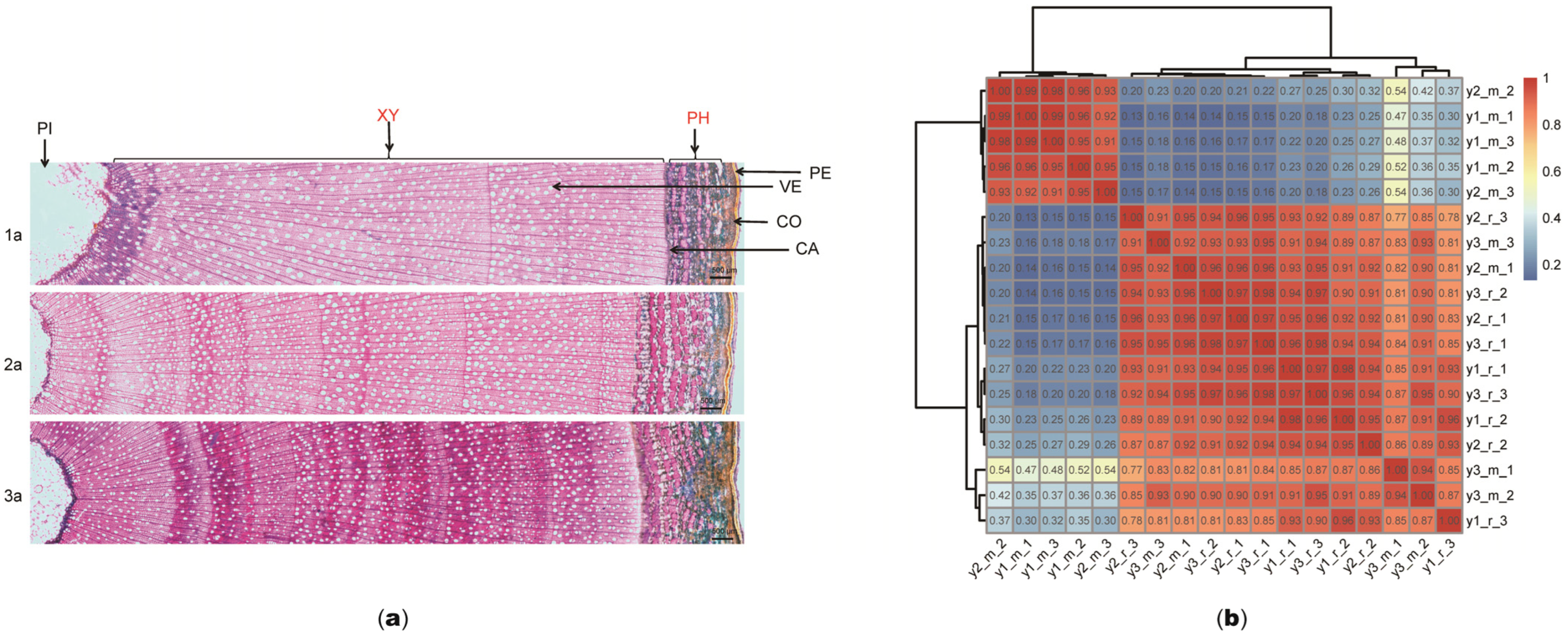
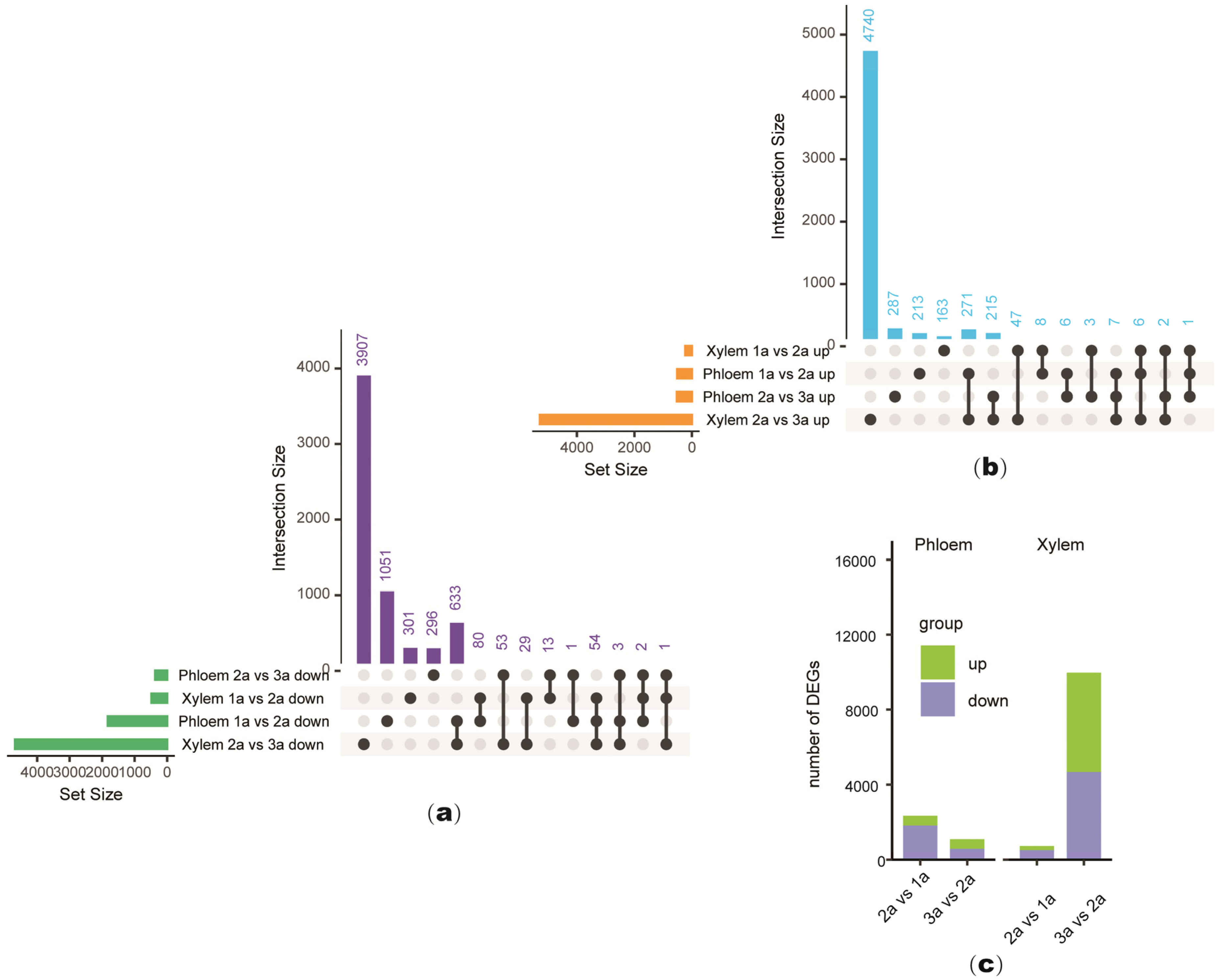
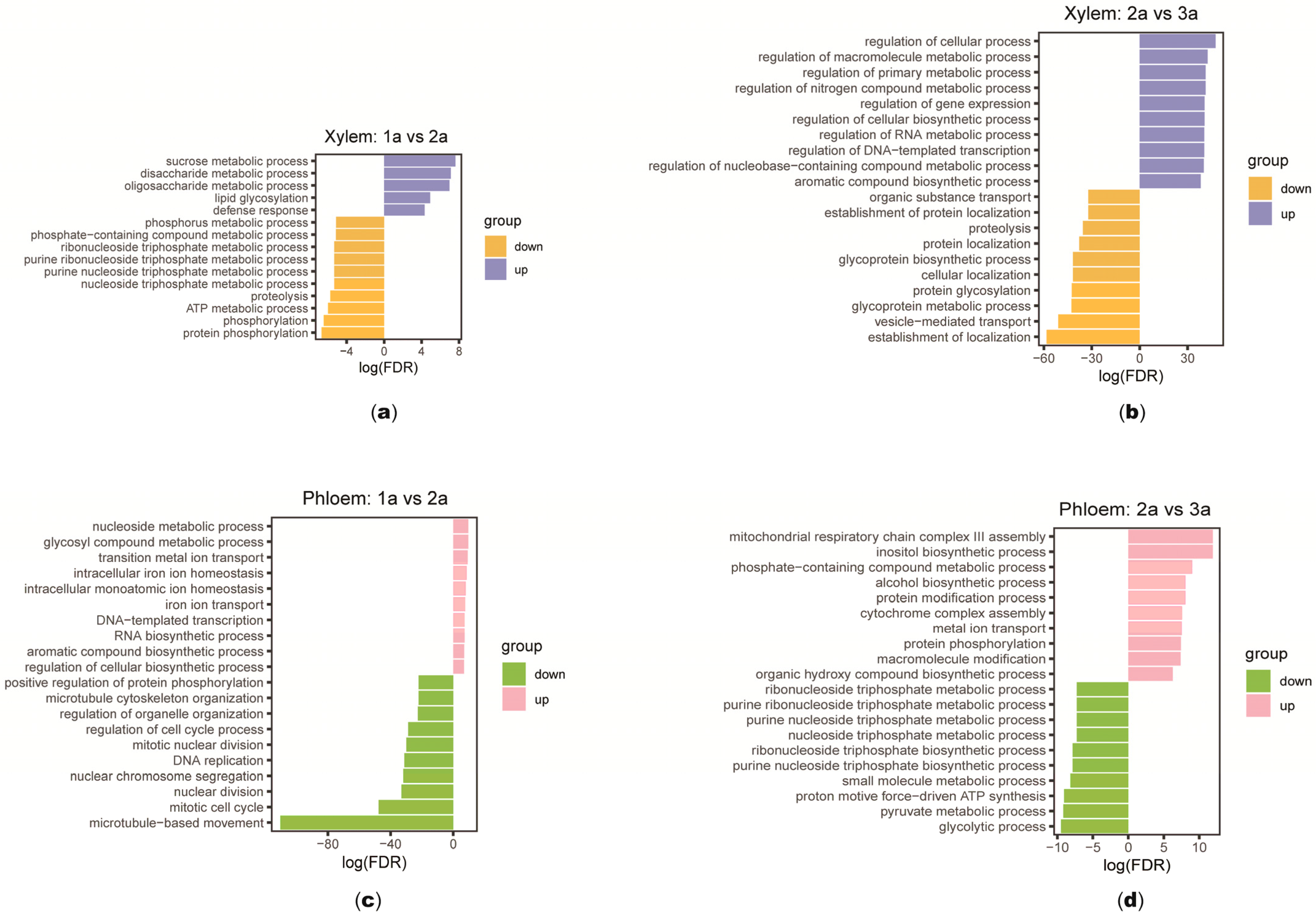
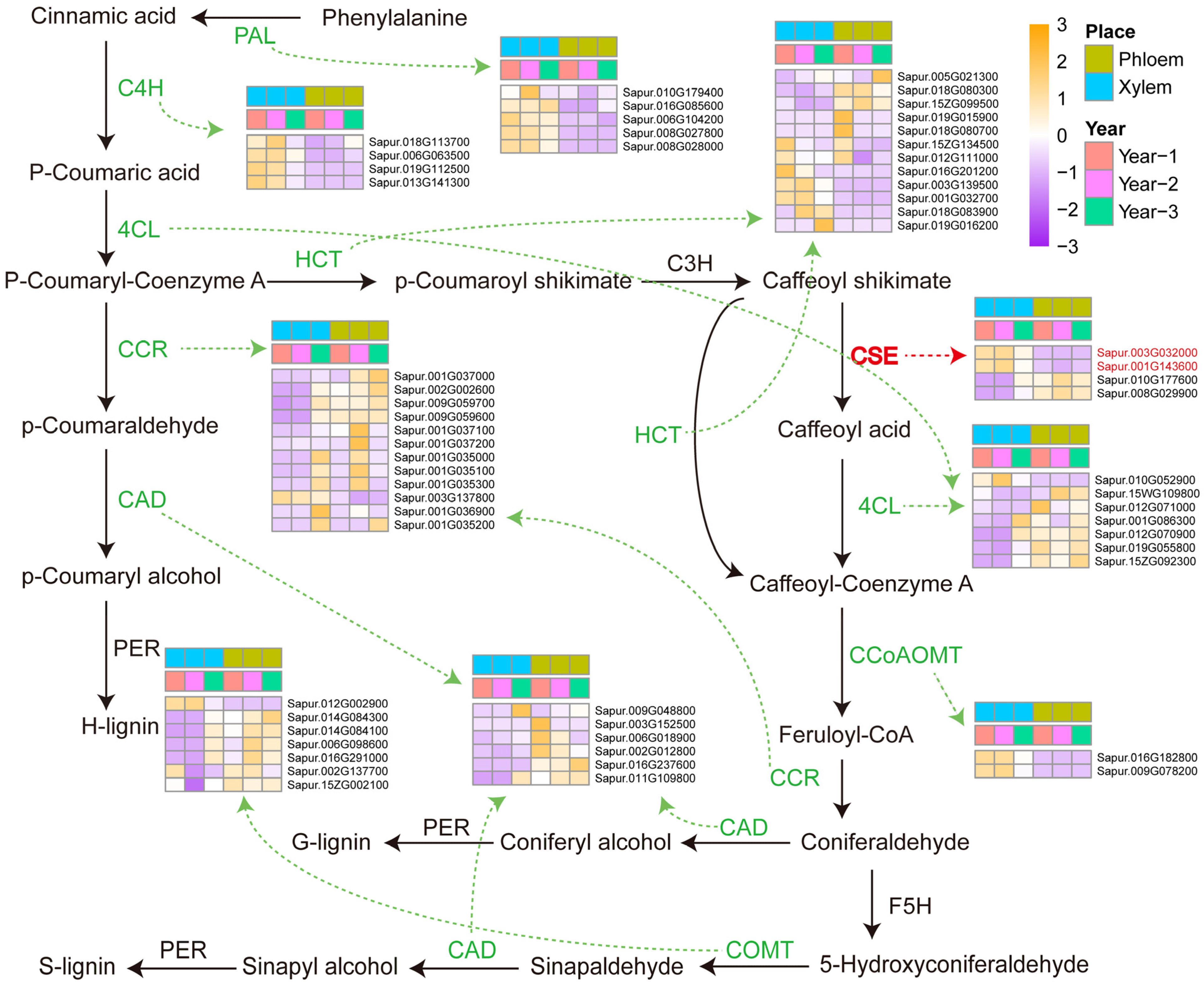
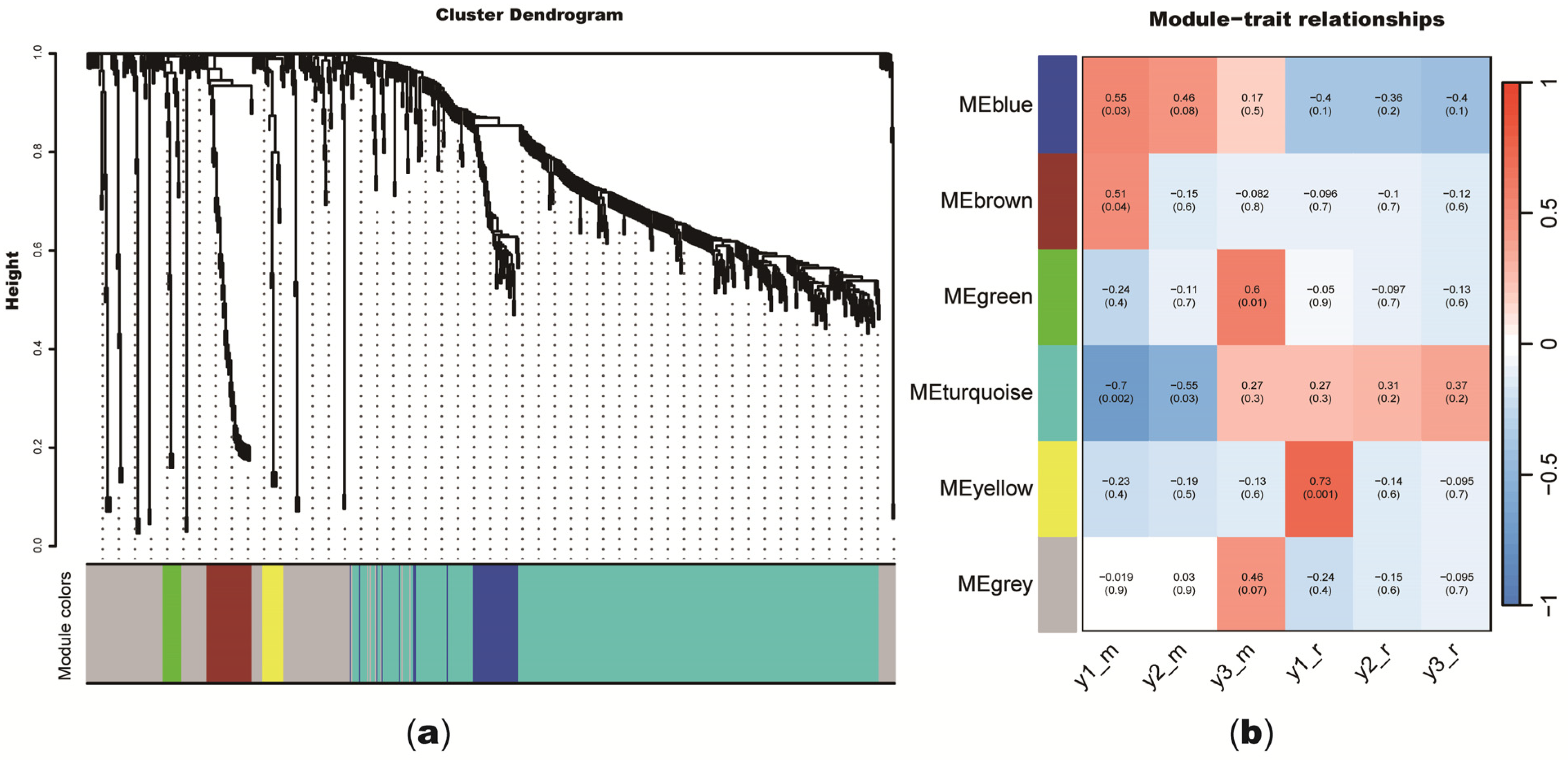
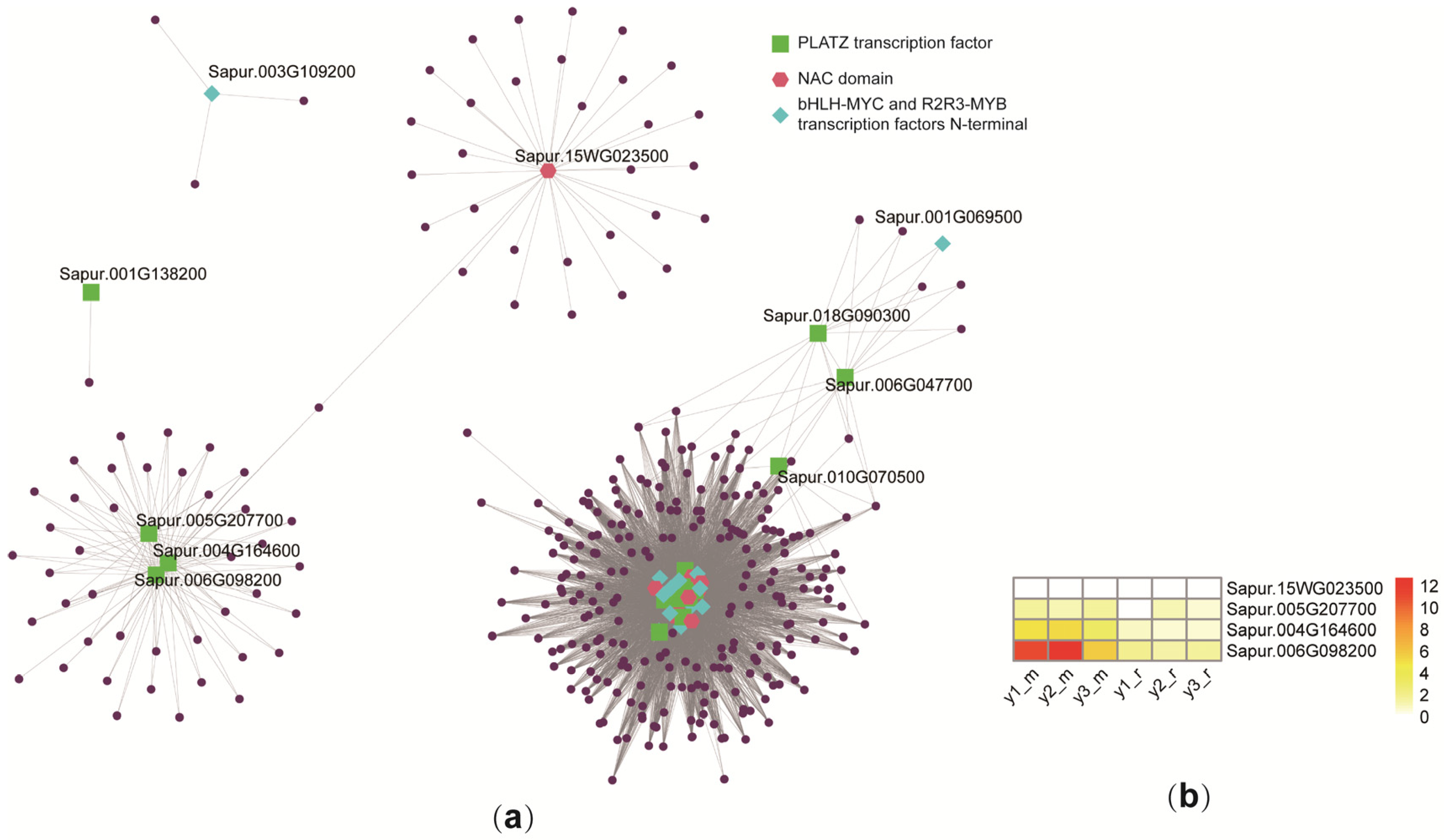
| Tree Height/(m) | Average Value/(m) | Basal Stem/(cm) | Average Value/(cm) | |
|---|---|---|---|---|
| 1a_1 | 2.33 | 2.61 | 0.93 | 1.22 |
| 1a_2 | 2.79 | 1.40 | ||
| 1a_3 | 2.70 | 1.33 | ||
| 2a_1 | 3.06 | 2.92 | 1.60 | 1.43 |
| 2a_2 | 2.89 | 1.50 | ||
| 2a_3 | 2.80 | 1.20 | ||
| 3a_1 | 3.74 | 3.39 | 1.87 | 1.83 |
| 3a_2 | 3.10 | 1.83 | ||
| 3a_3 | 3.32 | 1.80 |
Disclaimer/Publisher’s Note: The statements, opinions and data contained in all publications are solely those of the individual author(s) and contributor(s) and not of MDPI and/or the editor(s). MDPI and/or the editor(s) disclaim responsibility for any injury to people or property resulting from any ideas, methods, instructions or products referred to in the content. |
© 2025 by the authors. Licensee MDPI, Basel, Switzerland. This article is an open access article distributed under the terms and conditions of the Creative Commons Attribution (CC BY) license (https://creativecommons.org/licenses/by/4.0/).
Share and Cite
Qiao, H.; Wang, Y.; Shi, L.; Wang, R.; Yang, Y.; Wei, D.; Li, Y.; Chao, K.; Jia, L.; Liu, G.; et al. Insights into Molecular Mechanism of Secondary Xylem Rapid Growth in Salix psammophila. Plants 2025, 14, 459. https://doi.org/10.3390/plants14030459
Qiao H, Wang Y, Shi L, Wang R, Yang Y, Wei D, Li Y, Chao K, Jia L, Liu G, et al. Insights into Molecular Mechanism of Secondary Xylem Rapid Growth in Salix psammophila. Plants. 2025; 14(3):459. https://doi.org/10.3390/plants14030459
Chicago/Turabian StyleQiao, Hongxia, Yunhan Wang, Lin Shi, Ruiping Wang, Yeru Yang, Dongshan Wei, Yingjie Li, Kairui Chao, Li Jia, Guiming Liu, and et al. 2025. "Insights into Molecular Mechanism of Secondary Xylem Rapid Growth in Salix psammophila" Plants 14, no. 3: 459. https://doi.org/10.3390/plants14030459
APA StyleQiao, H., Wang, Y., Shi, L., Wang, R., Yang, Y., Wei, D., Li, Y., Chao, K., Jia, L., Liu, G., Yu, F., Zhang, J., & Yang, H. (2025). Insights into Molecular Mechanism of Secondary Xylem Rapid Growth in Salix psammophila. Plants, 14(3), 459. https://doi.org/10.3390/plants14030459







